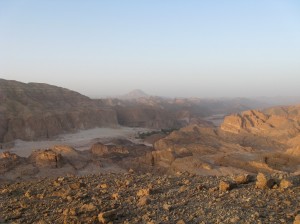
‘Lady’ Colleen Heller
By ‘Lady’ Colleen Heller
Nuweiba is an oasis tourist town on the coast of South Sinai, Egypt. It is located 70 km south of Taba and 180 km north of Sharm El-Sheikh and only 110 km from the famous mountain of Saint Catherine. In the early 1980s, after the withdrawal of Israel from the peninsula, Nuweiba became a favourite destination for independent travellers due to its ideal location and its natural beauty.
Investors discovered the commercial value of the virgin beaches between Nuweiba and Taba and opened deluxe hotels to encourage tourism along the coast. This must have seemed a great idea at the time, but due to several difficulties many hotels were never completed, leaving behind many half constructed cement buildings. That does not make for a pretty or inviting sight, but leave these behind and carry on to the oasis towns, where the water and the land still hold the magic that is Sinai, and you will not be disappointed.
On the road to Nuweiba from Cairo
The views of the landscape you will encounter as you make your way towards Nuweiba are spectacular and expansive. Along the roads you will have your first glimpses of the life of the Bedouin women. They often travel, one or two at a time, along the sides of the road. Sometimes accompanied by small children, they move their sheep from place to place and shade to shade in the incessant heat of the desert.
Nearly all Bedouin women wear black but their clothes often have designs of brightly coloured glass beads, sewn on by hand in intricate patterns. The sun reflects off the designs, giving each garment a hint of character and a glimmer of brilliant sun-kissed colour that make the women stand out against the neutral colours of the surrounding sands.
Donkeys carry packs with necessities like water, tea, sugar and some small food items like bread, cheese and tomatoes. Sometimes you will see someone riding on a donkey but that is not why they are there. Their job is to carry wood and other articles the women collect while searching for food for the goats and sheep back home. If they have no donkey the women will tie together what they find and sling it over their backs or carry it on their heads.
At the end of a long hot day, the women make their way back home, where they sort through what they have collected during the day, cook, clean, sew or bead until the late hours of the night. They work by the light of the fire and by candle light until sleep overtakes them. To start the cycle again tomorrow as the sun rises.
The main Bedouin Tribes of Nuweiba Medina and Mena, the city and the port of Nuweiba
The original residents of Nuweiba are a mix of the two Bedouin tribes El-Muzena and El-Tarabin. There are many tribes in Sinai, all distinguishable by dress and sometimes by facial features, but these two large tribes have been in Nuweiba for centuries.
There have been many marriages between the tribes and new couples will settle in the area that the husband is from. Each tribe will boast of the beauty and characteristics of their tribal women. Children from inter-tribal marriages often have unique features that are a blend of both tribes’ characteristics.
The areas in Nuweiba
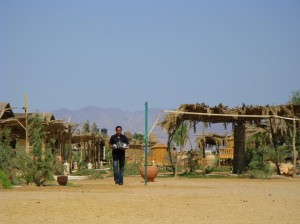
‘Lady’ Colleen Heller
Nuweiba Tarabin, the northern part of the city, consists of a thick grove of palms, a shallow bay off the Gulf of Aqaba and the ruins of a Turkish fort. The well inside the ruins served the Bedouins as a freshwater source for centuries. Along the beach there are many outdoor restaurants, furnished in Bedouin style with carpets and cushions that invite you to lay back and relax, have a tea and let life pass you by.
In Medina, you will find the post office, the court house, bazaars, supermarkets, rarely functioning internet cafes and restaurants which cater to your basic needs. There is a garden cafe in town for tourists and residents alike on the main street of this four street city.
The only banks are found in Mena, Port of Nuweiba. About 20 minutes away by vehicle, so be prepared to plan your cash needs properly. Credit cards are usually not accepted for small purchases and sometimes larger ones as well.
The Dunes Beach is the connection between Nuweiba Medina and the Nuweiba El-Muzena tribal village. Camps and family owned hotels are situated on beautiful sandy beaches with spectacular coral reefs lurking just under the surface of the sea. Originally, The Dunes was divided into Big Duna and Small Duna but over the past years Centre Duna came into being too.
Most of the campsites and hotels can be found in Centre Duna and Small Duna. There are still many romantic, untouched places that offer simple accommodation of thatched beach bungalows or huts for you to let go of the stresses of daily life and enjoy the breathtaking nature around you.
The food in the camps is always prepared on site and can consist of freshly caught fish and fresh vegetables, while the hotels will often use frozen processed food. Make sure to sample the fresh juices that will quickly become your favourite holiday drink.
One of the best things about staying in a camp is when, at night, tucked in under your mosquito net, you listen to the sea gently lull you to sleep. There are many camps to choose from and many are similar but what will make your stay a great success will be the quality of the food. Green Beach Camp in Nuweiba is beautiful and offers wonderful food. It has been tried and tested and having a great person like Nasr around to cater to you and your children’s needs is a gift. After 17 years in the camp, he knows exactly what to do and who needs what to make their visit special.
Nuweiba Port, El-Muzena, also known as Nuweiba Village, is the area for trade. Originally Nuweiba port was the summer location for the El-Muzena tribe. It was a sparsely inhabited oasis, which only came to life in the late summer, when the tribe flocked to the palm groves to pick the dates.
The thriving trade encouraged the clan to settle. A port was built in 1985 to facilitate business between Egypt and the Arab countries on the other side of the Gulf of Aqaba. Homes and schools were built, shops and business centres opened and the first hotels, like the Hilton, were established. This area has mix of the old culture and modern ways.
The desert
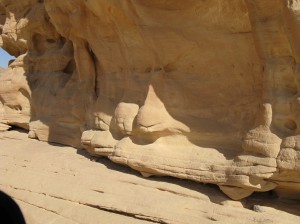
‘Lady’ Colleen Heller
In the desert, visiting the El-Muzena tribe, you will find the peaceful existence of the nomadic people. Their makeshift homes of card board, branches, metal and plastic pieced together to form accommodations is remarkable. Animals like goats and sheep, camels, birds of the desert and dogs are part of the Bedouin homesteads. Evenings are whiled away as food is cooked over fires while listening to the stories of the past.
After spending a little time in the desert, many people experience a sense of peace that they seldom find anywhere else. Personal retreats are common as well as group getaways for mountain climbing and survival trips. Business empowerment activities are just starting to become popular in the desert as a way to bring out inner strength and teamwork in each participant, and this new form of tourism is expected to grow in the future.
The desert tribal areas
In the desert, common courtesy exists amongst the tribes. When Tarabin tribesmen are passing through Muzena lands, either by camel or jeep, they wave and keep moving. Old timers who know each other, or of each other, will stop out of respect to have tea before moving on. Unless there is a family squabble, then no one will stop and there is hardly a wave.
Even if everyone has cell phones these days, communication still comes on foot, camel or jeep. Sharing news and tea is one of the nomadic people’s traditions.
If there is a dispute within the tribe it needs to be discussed and you will find the men in a circle around the fire, while the women in their own area will do exactly the same. Long hours will pass with talk and some harsh voices will be raised, but mind you, the Bedouin have a certain harshness to their voices in the best of times. It is not always easy to tell if they are angry or just speaking at a normal level.
Desert trekking
The nomadic Bedouin way of life was coming close to an end when I first went out to the desert in 1999. There are still a few Bedouin left who have no one place to call home, but most Bedouin live in one area of the desert and have water brought to free standing wells made of cement blocks – removing the need to search for water. Before this time they would move to different places from season to season, water and heat dictating the move.
Bedouin know where the water is in the desert and where the goats and camels will find trees and green plants to eat. This knowledge has passed from generation to generation and been used for centuries. Times have changed though, and with them the tribe.
A typical trek can be made with camels, jeeps, or on foot if you wish and can take from two to ten days, or more. Traditionally you will leave early in the morning, before the heat of midday, and you will arrive at the first location at lunchtime where there will be shade and food awaiting you.
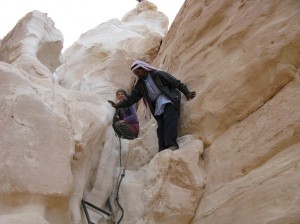
‘Lady’ Colleen Heller
The first thing that will be prepared at every stop on the fire will be tea. The fire for the tea seems to appear out of nowhere, because the Bedouins are quick when it comes to the hot, sugary drink that sustains them. Tea without sugar can be made for you but it is a good idea to ask for it before your journey starts, as usually there is only one pot available.
All food will be served community style. You will have your own plate and cup but some items are passed around amongst everyone and if you do not want to share plates it is best to mention this to your guide. Bedouins tend to treat their guests as family and a Bedouin family shares everything.
The Bedouin mostly use their hands to eat. You will be given utensils but most likely will share the same very big plate with everyone else. Simply section off the area you will eat from and no one will come near your area unless you back away to signal you are done eating.
When out on a journey, the younger guides sometimes do not have the experience to accommodate for the fact that foreigners often prefer to have basic items for their own use. If you want to embark on a trip for the full Bedouin lifestyle, make sure you share this with the more experienced guides before they offer a more western and sanitised version of the itinerary.
During your time in the desert you will have the opportunity to see and visit wadis (valleys), oases that offer clear cool water in the depths of the desert, ancient sites like Nawamis (stone tombs), colourful mountains that light up during sunset, camels, goats, cracks in the earth where, once you climb down, you will find bright white sand, hidden canyons, ancient writing carved into stone, trees that survive on hardly any water, and natural amphitheatres.
Night time camps are prepared quickly and may involve tents but sometimes the places to sleep will be set up under the stars. Warming fires are lit and kept burning throughout the night, with the never ending pot of tea at the edge of the fire just in case you feel the need for an extra dose of the hot, sweet drink.
As the day ends, look up. Better yet, sleep outside even if tents are set up for you. Falling asleep, looking at the universe as your roof and the stars seem within reach is an experience you will treasure for many years to come.
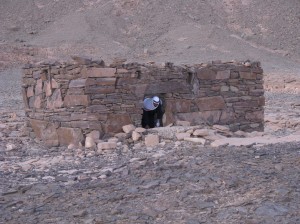
‘Lady’ Colleen Heller
Dawn signals the start of your day and as the sun rises, you will be eating breakfast and get ready to continue your journey. Before you know it everything is packed up, the programme for the next few hours explained and you are off again to explore this amazing land.
You can do your research and set the programme for your trip together with your guide or you can just let the Bedouin do the job they know so well. The desert is part of them and if you give your guides the chance they will proudly take you around to share its treasures with you.
What I like the most about the desert Bedouins is the love they have for their land and their happiness if you love it too. If you get along with your guides you might get lucky and get treated to an evening of songs accompanied by the Oud around the fire. The Bedouin play in celebration of their love of the desert and her visitors. And that would be you.




